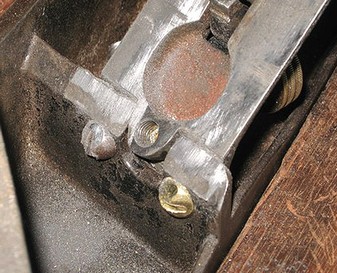
The #51 Shooting Plane: Stanley and Lie-Nielsen
The reviews I have offered in the past tend to follow the rule that the tool in question is newly available and I believe will be of interest to many as a potential purchase. The spotlight here falls on a tool that is expensive and, like many of us that watch Top Gear, only a few are seriously interested in acquiring one. Of course we watch – or read – because we are fascinated by tools and tools-as-art. Perhaps one day …
About 10 years ago I was introduced to the Stanley #51 shooting plane and #52 shooting board combination by a good friend, who had recently acquired one. Peter’s workshop was completely handtool orientated, and the #51/52 was the centrepiece. God how I coveted that shooting board! However I could not justify the expense, and in any event they were as rare as hens’ teeth in Australia.
I do have a special fondness for the shooting board, as is apparent from my posts on forums and a number of articles on my website. It is not simply that one can take a hand sawn board and then cleanly square its end, but the pleasure of experiencing the blade removing shavings as it slowly and with precision moves fractionally closer to the knifed line. Alongside the dovetailing of drawers, fitting drawer fronts is one of the areas of cabinetry that I most enjoy.
Well five years went by. And then I came across an auction on eBay (Australia) for a Stanley #51/52. It looked in good condition, save for the absence of the hold down (which almost always goes missing), and that the frog in the #51 plane had a welded repair.
The welded frog. That is the bane .. and fate .. of so many Stanley #51s. Stanley, in their infinite wisdom, designed the frog on the #51 to resemble a highwire artist balancing precariously … well … on a highwire. This does not create a solid base – further bearing in mind that these planes are constructed from fragile grey iron. One drop from the bench …

The frog is the same size as a #3 (even though the blade used is the 2 3/8” width for a #5 ½), but the attachment is quite different. Where the #3 frog bolts to the base of the plane, the frog of the #51 attaches to the side of the thin bridge across the plane’s body.
Here are the frogs of the #51 (left) and #3 (right) alongside one another …
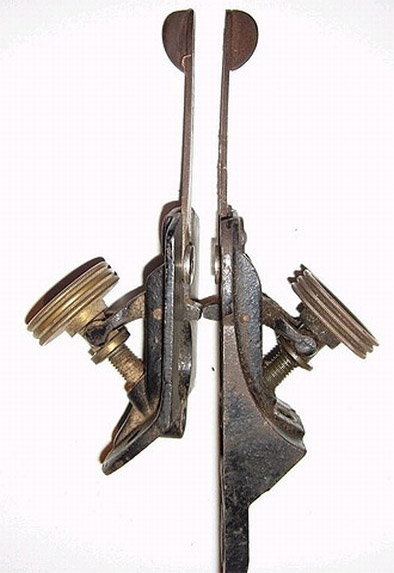
Did I mention that there are no .. repeat no, nada, zip .. replacements available on Planet Earth for a broken #51 frog?
And this is probably the reason why I won the auction for a reasonable amount, somewhere around a third the market value for a combination that included a plane in sound condition.
The trials-and-tribulations of the restoration of the #51/52 are documented here. The long-and-short of it was that the frog remained welded and I modified the mouth with an attachment to bring the frog and mouth support into coplanarity.
The end result, however, was a tool that has brought great pleasure to use.

What is so special about the #51/52?
Stanley offered this combination between 1909 and 1943. As far as I am aware, they did not offer the components separately.
Briefly, the #51 shooting plane is dedicated to shooting and specifically designed to be used on the #52 shoot board. The #51 is “L” shaped. The lower section rides inside a track on the #52, which holds it in position both in the vertical and horizontal. One of the difficulties with a shooting plane on a shop made shooting board is that the plane has to be forced against the side fence and runway to prevent it rocking. Of course a plane that rocks as it cuts is going to produce a poor result. Note that I am not implying that shop made shooting boards do this – it is very easy to build simple shooting boards that work well. I am just emphasizing the strength of the #52, and that it makes the process easy.
Another of the special features of the #51 is that is cuts with a skewed iron. Most planes have a blade that is seated square (90 degrees) to the body, but the #51 is angled at 20 degrees. This enables the plane to make a slicing cut, which is not only cleaner on end grain, but as it enters the wood progressively, there is less jarring and less effort required.

The Stanley has only been available as a right-handed plane and shooting board. The plane is, in fact, impossible to hold in the left hand. I did note that the designation of the LN is “#51R”, which suggests to me that Lie-Nielsen plan right- and left-handed versions.

#52 Shooting Board. Adjustable side fence on the right side.
The other feature of the #52 shooting board is the adjustable fence. This has variable placement for degrees 45 – 90, with stops at the these extremes.

While the #52 shooting board is specifically made for one plane, the #51 shooting plane can be used with any shop made shooting board … which brings us closer to the start of this review. A few years before Lie-Nielsen released the #51 (several months ago now), Thomas Lie-Nielsen asked me in email correspondence about my impressions. This was the first I was aware that LN were planning to offer this plane – and what really interested me was that LN was planning to modify the original design by incorporating the standard frog from a #5 ½ jack. This made perfect sense to me, so-much-so that I said to Thomas that I would buy one when it came available.
Fast forward to January this year, just a month ago. Guess what my birthday present was? Am I spoilt or what! Yes. Allow me to share this as best as I can with all of you.
Design Changes
Out goes the weak area of the #51, and in come a new frog and a thicker blade and cap iron, all of which will add rigidity and mass.
The original blade in the Stanley is about 2mm thick (or should I say “thin”?). I use a Japanese Smoothcut, which is a laminated blade. This is the same thickness as the Stanley. To increase stiffness I added a Clifton twin-set cap iron, which is a hefty bugger … especially noted when the front piece drops off and lands on your toe (DAMHIK!). I epoxied the two pieces together (that will show it!).
The LN blade (on right, below) is about 3 ½ mm thick and the cap iron is roughly another 3 mm, making for a solid combination.

The LN arrived with a flat 25 degree primary bevel on the A2 steel blade. The usual LN recommendation is to add a 30 degree secondary bevel, which is the industry recommendation for A2 steel. However, since I have used A2 very successfully on end grain for many years, I decided to hollow grind the blade at 25 degrees and hone on that. A few strokes on this edge were not successful with fine chips evident. I do not consider this to be an issue – it is very common for new blades to be a little brittle at the edge, plus the lower angle would not be offering the steel its best condition for use. Consequently I reground the edge to 30 degrees, which also allowed me to remove about 1/32” of steel. The result was excellent, simply perfect – there was no sign of chipping, and just good edge holding, after an afternoon of playing with the plane on some very hard woods.
As mentioned earlier, the frog is an area of significant improvement. Below are the Stanley to the left and the LN on the right. It is obvious how much extra bedding and blade support there is on the LN.
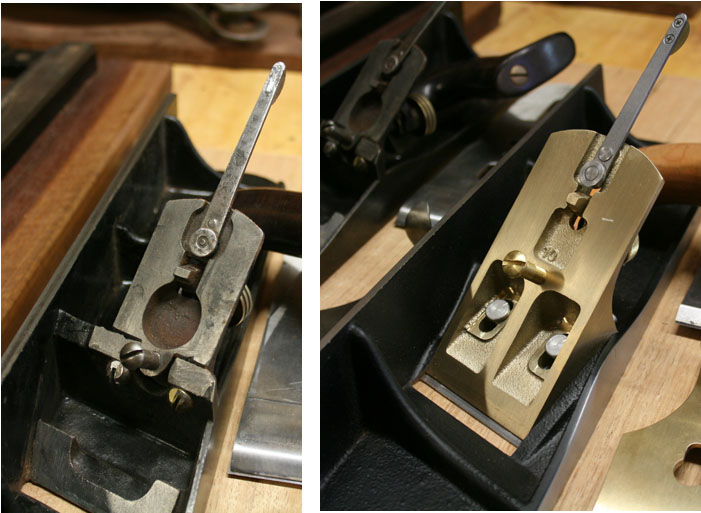
And the LN is a Bedrock design! Not only is the Stanley not, but is does not have any means of adjusting the size of the mouth.

There are also changes in the body. The base is the same width (well it must be exactly the same to work in the #52 shooting board). However ..
Both planes are essentially 15” long. My Stanley is about 1/8” longer, which is not significant …

… while the LN is taller by ½” (probably to accommodate the wide #5 ½ frog) ...
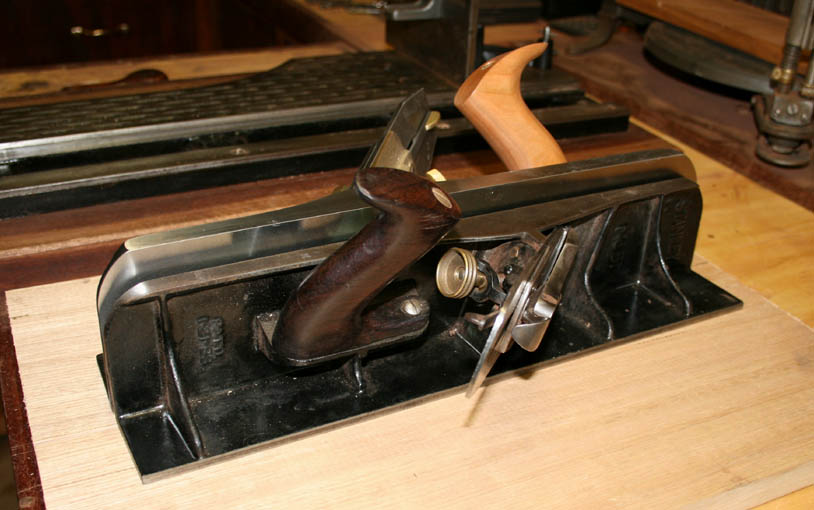
Lastly, the totes are similar in profile with the LN a little thicker, feeling chunkier to hold. This made it feel a little short in my hand.

As expected, the fit and finish are first class.
One last touch I will mention is something unexpected. I am unsure if this applies to all the LN #51s made, or whether this is only for the first 100 made (as I received a certificate with my plane stating it was such). As with the #4 ½ Anniversary plane, this #51 is signed by Thomas Lie-Nielsen …

Edit:
A reader mentioned that his plane was not signed and that he believed
that the addition was unique. I asked Thomas if this was so, and he
replied, “I thought you would appreciate the signature...”.
Thank you again Thomas for making the #51 a special memory.
#51 versus #51 in action
When hefting the two planes subjectively they did not feel different. The Stanley is, however, specified as 7 1/8 lbs, while the LN is given as just over 9 lbs. In action this difference is very evident.
Both planes produced excellent performances. Both glide along the rails like a train making light work of softwoods. The LN was clearly better on the hardwoods, which were used here to test their mettle. It took longer shavings, with more ease, and inspired more confidence in the expected outcomes. The cause of this is no doubt a combination of the extra mass along with the better blade/frog combination. The Stanley was not far behind in results, and the wood surfaces looked the same for both planes.
Here is the LN planing ¾” thick Tasmanian Oak (similar to White Oak) …

And here is the Stanley’s effort …
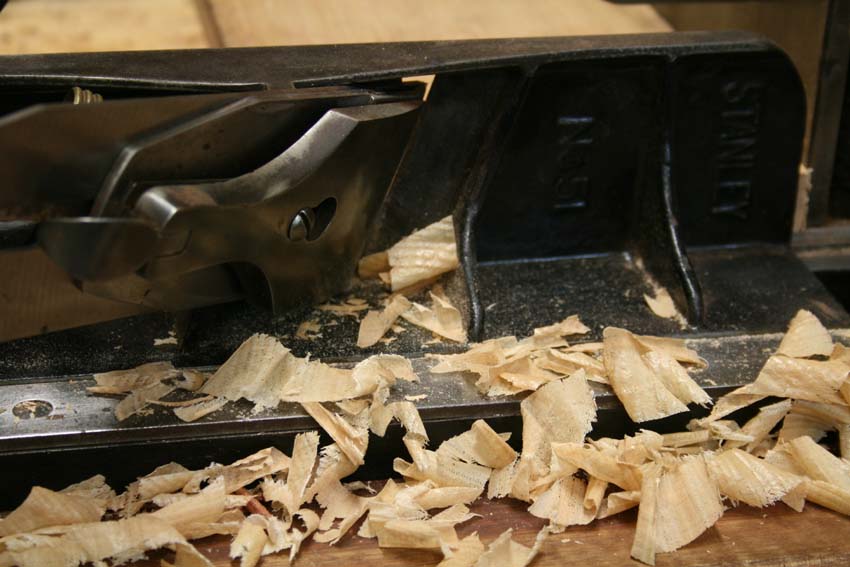
There is a difference – the Stanley just could not produce the full length shavings that the LN did so effortlessly. The reason appeared to be that the lower mass of the Stanley (which is still a very hefty plane by common standards) would slow down half way through the 6” wide board, and the shaving would break.
To be sure I retested the LN. And once again it produced full length shavings, effortlessly.

Results on a ¾” hard Jarrah board were similar. LN on the left and Stanley on the right …

… full length shavings from the LN and half-length from the Stanley.
A few more action shots …


In Summary
There’s not a lot left to say about the LN #51 that has not been demonstrated. This is a very fine shooting plane in the very best tradition of vintage Stanley. It has not only re-created the Stanley #51 it has improved it, and it has done so in a manner that would likely go unnoticed by all but those experienced with the original plane (and now you of course dear reader). The King is dead. Long live the King!
Regards from Perth
Derek
February 2011